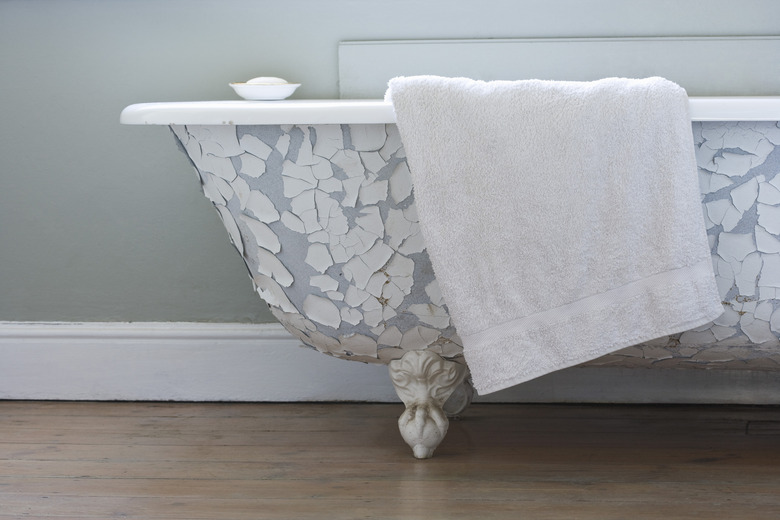How To Determine The Age Of A Clawfoot Tub
Bathtubs didn't become popular in the United States until the late 1870s, after plumbers had figured out how to vent waste lines, thus making residential plumbing a practical reality. Clawfoot tubs made their first appearance around this time but didn't become a "thing" until the early 1900s. Tub manufacturers identified their products with stamps that often included the date of manufacture. Locating the stamp is the best way to tell how old a particular clawfoot is, but if the stamp missing, you may have to make the determination from the condition of the tub and other factors.
Look for the Stamp
Look for the Stamp
Modern clawfoot tubs may be made of acrylic or fiberglass, but the original ones were cast iron coated with porcelain enamel. The cast iron is exposed on the outside and bottom of the tub, and although it may have been painted, the manufacturer's stamp — if there is one — is often clearly visible. Sometimes you'll only find the words "Made in U.S.A." This stamp may be on the bottom of the tub or it may be on the back just under the drillings for the faucet and shower head.
Next to the manufacturer's name or the "Made in U.S.A." logo, you often find the date of manufacture in the month/year format. For example, the numbers 12 31 state the manufacture date as December 1931. You might also see another number, such as 5 1/2. This number states the length of the tub in feet. Possibilities include 4, 4 1/2, 5, 5 1/2 and 6.
Early Manufacturers
Early Manufacturers
Several companies pioneered the manufacture of clawfoot tubs in North America: Crane, Mott, Kohler, Standard Sanitary Manufacturing — identified by its logo SSM — and the L. Wolf Manufacturing Company. Standard Sanitary Manufacturing merged with American Radiator in 1929 to become American Standard, so the presence of an SSM stamp immediately identifies a vintage tub. The L. Wolf Company of Chicago company produced clawfoot tubs in the late 1800s and early 1900s, as shown in a catalogue supplied by the Encyclopedia of Chicago, and its stamp is also a sign of age. Crane, Mott and Kohler tubs aren't necessarily old, but they may be.
Other Dating Methods
Other Dating Methods
The absence of a stamp on a cast-iron clawfoot tub could mean it's a mid-20th century generic model, but it could also mean the tub was produced before stamping became commonplace. An unstamped tub that lacks faucet drillings could have been custom-made for a well-to-do household in the mid 1800s or earlier. Older tubs are likely to be double-rounded rather than having a squared-off end, or they may have a raised end to support the back of the bather (called slipper style).
Some clawfoot tubs have feet that have been obviously added on, and this often means the tub is old enough to have been refinished and restored. In some cases, the original feet were replaced with new ones, and in other, more rare cases, an old bathing tub that was manufactured in Europe — perhaps made of copper and almost certainly lacking drillings — was retrofitted with new feet. These tubs aren't necessarily more valuable than real vintage cast-iron clawfoots, but they may well be, and they are definitely older.
Color: White was the color of choice for early clawfoot tub manufacturers. Pastels weren't used until tubs were mass-produced in earnest during the post-World War I manufacturing boom, and they didn't become popular until the 1930s. A yellow tinge on an otherwise white surface coating on the inside of the tub is an obvious sign of age. It takes years of bathing for that to happen. The white color can be restored by a skilled bathtub refinisher.
